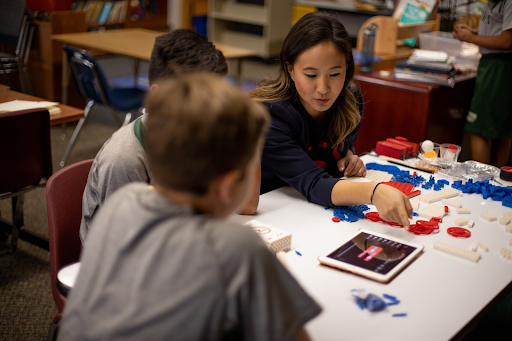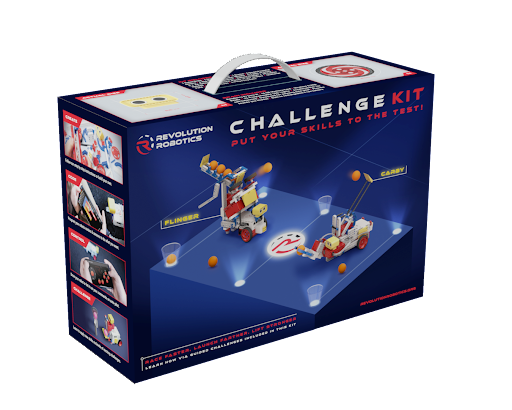Robotics might conjure a mental image of precision design, fabrication, and coding, all of which demand a lot of money and skill. While there’s certainly some truth in that image, nonprofit Revolution Robotics is working to make the field accessible to a much wider range of students—while using robots’ inherent fun factor to expose more kids and adults to the science, technology, engineering, and math (STEM) disciplines.
Revolution Robotics brought Rosemary Hua on board as its CEO for a combination of her profit skills and non-profit inclinations. As the Global Head of Retail and CPG at Snowflake, Hua has top-shelf experience in a corporate organization. As the founder and Executive Director of Empathy FX International, she has hands-on skills developed in the nonprofit sector.
The founders of Revolution Robotics were also the founders of Numerator, one of the largest omnichannel panels of consumer data in the world. While some corporate experts and entrepreneurs can be devoted in a very monomaniacal way to for-profit endeavors, others want to leverage the skills that made them successful into making others successful. So, Jared Schreiber and his partners started Revolution Robotics and hired Hua as CEO.
Hua is a great example of how much for-profit skills can translate into organizational and leadership talent. But her corporate work benefits from her nonprofit undertakings as well.
Building diversity in STEM
“My professional life has all been in data analytics and the technology space,” Hua said. “And I am female, Asian, and young. Those three attributes don’t always make up the majority of boardroom meetings in large corporations, but I would like to see more young, female minorities who are interested in STEM and pursue it in their careers or academics.”

Hua said that without diversity, a limited set of biases will be codified into the models that tech companies build. “That’s why I am a huge part of Revolution Robotics, because it inspires young girls and young ladies to get involved in technology, in STEM, and in data.”
Hua’s involvement in the nonprofit sector is older than her corporate career.
“I started off building a global nonprofit all the way back in 2009,” she said, referring to Empathy FX International. “We built five schools in Ghana, and we still maintain and operate those schools today. I visit Ghana every year, as I have for the past eight years.”
Success alone cannot create fulfillment, according to Hua, nor can the satisfaction that comes from it.
“Contentment and positive feelings don’t fully make up the concept of happiness,” she said. “But rather, deep meaning and fulfillment in what you’re doing. And so, if I don’t find all of those four elements in my day job, I go and find it in my nights and weekends, which is why I decide to spend so much time in nonprofits.”
Why robots?
If your inclination is to wonder why kids would want to get involved in robotics, just think about Legos. They are an extremely popular toy but the large kits, such as the LEGO Mindstorm builds, are expensive. The kids who were doing the big kits were also the most likely to have engineer parents, Hua said. But the desire to build is not only an upper-class thing. So Revolution Robotics created kits that were reusable, with Raspberry Pi “brains,” used open-source tech, and provided at a reasonable price to groups such as schools.
According to Miller J. Roberts III, Senior Program Director for Revolution Robotics, the best way to think about the immediate appeal of robotics for young people is twofold.
“When you have a student who has been told that they aren’t good in math and/or science, who all of a sudden has this hands-on interactive experience that gets them involved and they are excited, you can’t help but be excited,” Roberts said. “You also encounter students who, in the past, haven’t been able to have good teamwork experiences. I can’t tell you the number of parents who have come to me and said, ‘My child is not a sports person. They haven’t had a lot of good group activities, but somehow robotics is his or her thing and this worked.’”
“When little kids tell you that they stayed up all night to work on their robots because they want to win the competition, there’s just nothing better in the world.”
But the organization has not just given students access to team activities and competition and academics they might not otherwise have had. It has also given opportunities to the adults.
A question Roberts hears often from adults who want to launch or coach a robotics team is, “How much experience do I need?”
“Actually, it’s better if you don’t [have experience] because then you aren’t going to tell the students what to do,” he said. “Engineering is about ingenuity and creativity, and if a student thinks that there’s a set answer to an engineering problem, you’re going to stifle their outcome. We’re really looking to make this approachable for everyone. It doesn’t have to be the math teacher or the dad who already works for an engineering firm. Anyone can lead the effort. A janitor at a school in Chicago said, ‘You know what, I really would like to be one of the coaches.’ And then he paired up with the school librarian and they did it!”
Post-COVID robotics
Like many undertakings, Revolution Robotics, which launched in 2019, was profoundly affected by COVID-19. It had to hit the brakes pretty hard, and is one of the reasons Hua ended up at Snowflake instead of working at Revolution Robotics full-time. But despite that, the kits were popular enough that the organization is close to selling out its initial run of 1,000, released two months before the pandemic.
The second run will produce 10,000 kits.
“Despite COVID, school systems supported robotics teams and we did virtual classrooms and virtual competitions,” he said. “That was really incredible. I had teams that were in California, Maryland, and Texas. We had some folks over in Hungary. So things went forward.”
Roberts thinks we are still in the infancy phase of getting robotics into schools. That being the case, entrepreneurs can play an important role in what Roberts says “should be just as ubiquitous as a basketball team or a baseball team.”

One of the big messages Revolution Robotics conveys is that there is no right way to do things and no limit to transformation. A VP can find profit in an atmosphere bereft of it, a janitor can lead a robotics team, and academic underachievers can fall in love with math.
